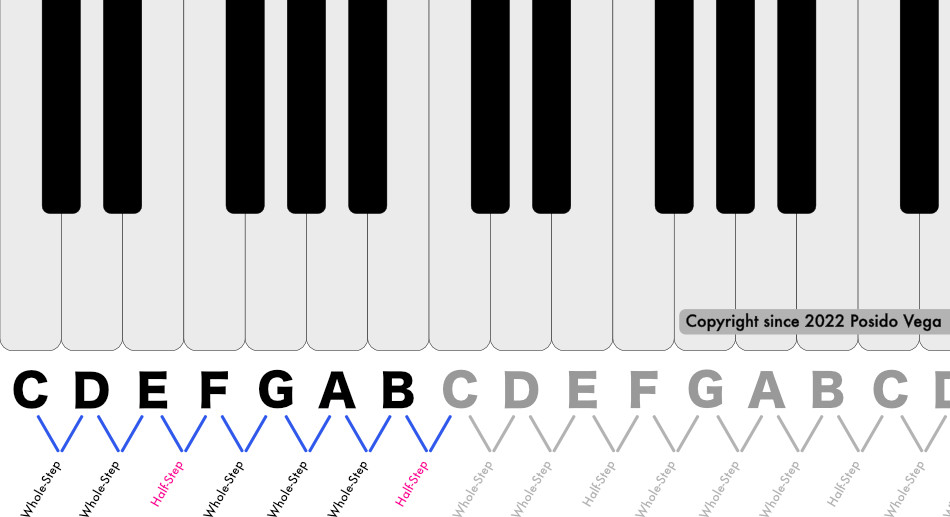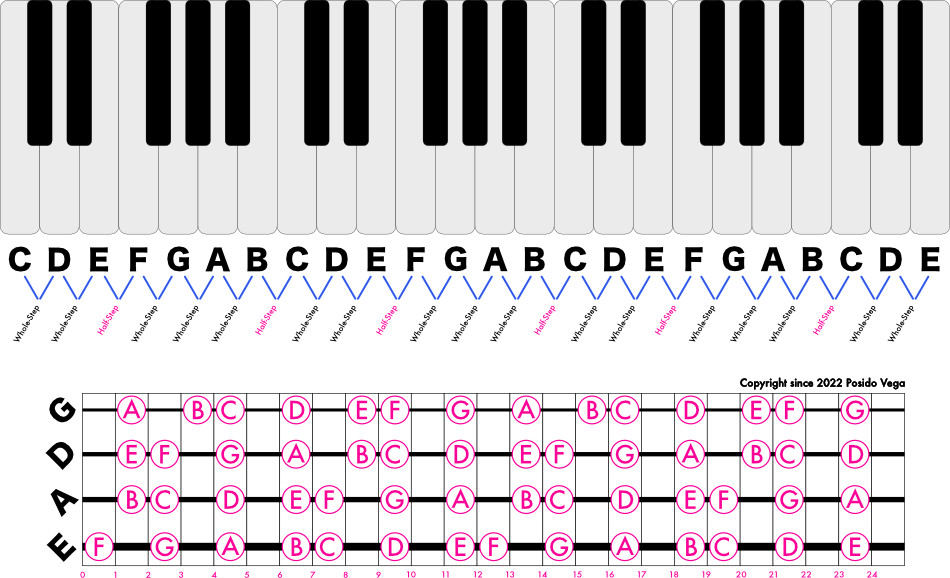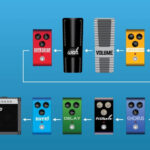For over a decade, I’ve guided countless bass students, and a recurring theme emerges: many, even experienced players, grapple with knowing all the notes on their bass guitar fretboard. This shouldn’t be a hurdle. Understanding your bass guitar notes doesn’t have to be a lengthy ordeal. The fretboard operates on a clear logic, and once you grasp it, everything clicks into place.
In this guide, you’ll discover: The precise method I’ve successfully used to learn the bass frets and notes in just two weeks. We’ll explore this step-by-step, ensuring you can effectively use a Bass Guitar Notes Chart and understand the fretboard thoroughly.
Let’s dive in and unlock your fretboard knowledge.
Your Step-by-Step Process to Learn Bass Guitar Notes (Using a Chart Effectively)
My proven method for mastering every note on the fretboard boils down to these four straightforward steps, which we’ll detail below, along with guidance on how to use a bass guitar notes chart in your learning:
Each step will be broken down, accompanied by diagrams and insights on how a bass guitar notes chart can aid your understanding.
Bookmark this page as your quick reference, especially if you’re new to bass or struggling to memorize the fretboard. A bass guitar notes chart, combined with these steps, will be invaluable.
TL;DR
If time is short, this video summarizes my approach to learning bass guitar notes quickly. Remember to use a bass guitar notes chart alongside the video for optimal learning.
 YouTube video
YouTube video
Learn Your Fretboard Bass Guitar Notes Fast! (4 Easy Steps)
Step 1: Understanding the Interval Logic of Notes (Referencing Your Bass Guitar Notes Chart)
Western music, in most genres, operates with just 12 notes. The quickest route to learning these is to understand their spelling logic, one note at a time. A bass guitar notes chart visually represents this logic.
Tip: Musical notes follow alphabetical order, A to G. Knowing this alphabet is more than halfway to mastering your notes.
A, B, C, D, E, F, and G are the 7 natural notes, akin to the white keys on a piano. This sequence repeats: A, B, C, D, E, F, G, A, B, and so on.
The remaining 5 notes are sharps and flats: A♯/B♭, C♯/D♭, D♯/E♭, F♯/G♭, and G♯/A♭. These are like the black keys on a piano, positioned between the natural notes. A bass guitar notes chart will clearly show you the placement of these sharps and flats on the fretboard.
Sharps and flats can be spelled in two ways (enharmonic spelling). While pitch remains the same, spelling varies depending on musical context. For beginners, fretboard mastery is the priority; understanding spelling nuances will come naturally later.
Whole-Steps and Half-Steps (Visualized on a Bass Guitar Notes Chart)
Observe a piano: black keys exist between white keys, except in two instances. This pattern is mirrored on the bass fretboard and easily visualized on a bass guitar notes chart.
Tip: No black key (or note in between) exists between E and F, or between B and C. This is consistent on any fretboard, bass or guitar!
 Piano keys – Whole-Step and Half-Step DiagramPiano keys – Whole-Step and Half-Step Diagram
Piano keys – Whole-Step and Half-Step DiagramPiano keys – Whole-Step and Half-Step Diagram
E-F and B-C are always a half-step apart (one fret). All other natural notes are a whole-step apart (two frets). A bass guitar notes chart highlights these crucial half-step and whole-step intervals on the fretboard.
Now, let’s apply this to the fretboard directly. The approach I’ll show is far less tedious than chromatic memorization, especially when you use a bass guitar notes chart as your visual aid.
Step 2: The Logic of the Bass Guitar Fretboard (Using a Bass Guitar Notes Chart)
Let’s recap key points:
- Musical notes are alphabetical.
- E-F and B-C are half-steps.
- Other natural notes are whole-steps (2 frets).
Here’s the most vital fretboard logic:
- Each fret = half-step.
- Two frets = whole-step.
On a standard four-string bass, open string notes are E, A, D, and G. A bass guitar notes chart typically starts with these open string notes as a reference.
 Bass Guitar Fretboard Notes and Piano Notes DiagramBass Guitar Fretboard Notes and Piano Notes Diagram
Bass Guitar Fretboard Notes and Piano Notes DiagramBass Guitar Fretboard Notes and Piano Notes Diagram
Focus on the lowest string, the E string. Start learning bass guitar notes string by string, using your bass guitar notes chart as your guide.
Remember: E-F and B-C are the only natural note pairs without an in-between note.
Finding E-String Notes (Easily with a Bass Guitar Notes Chart)
On the E-string, the first fret is F. Your bass guitar notes chart will confirm this immediately.
Following musical note logic reveals all natural notes on the E string:
- Fret 3 (two frets from F) is G.
- Fret 5 (two frets from G) is A.
- Fret 7 (two frets from A) is B.
- Fret 8 (one fret from B) is C.
- Fret 10 (two frets from C) is D.
- Fret 12 (two frets from D) is E.
- The pattern then repeats. Your bass guitar notes chart will show these repeating patterns across the fretboard.
Apply this learning to the A-string.
Finding A-String Notes (Simple with a Bass Guitar Notes Chart)
A-string note locations are:
- Fret 2 (two frets from A) is B.
- Fret 3 (one fret from B) is C.
- Fret 5 (two frets from C) is D.
- Fret 7 (two frets from D) is E.
- Fret 8 (one fret from E) is F.
- Fret 10 (two frets from F) is G.
- Fret 12 (two frets from G) is A.
- Again, the pattern repeats, and your bass guitar notes chart will illustrate this repetition.
Continue to the D-string.
Finding D-String Notes (Quickly Using a Bass Guitar Notes Chart)
D-string note locations are:
- Fret 2 (two frets from D) is E.
- Fret 3 (one fret from E) is F.
- Fret 5 (two frets from F) is G.
- Fret 7 (two frets from G) is A.
- Fret 9 (two frets from A) is B.
- Fret 10 (one fret from B) is C.
- Fret 12 (two frets from C) is D.
- Pattern repetition again, clearly seen on a bass guitar notes chart.
One string left! Let’s learn G-string notes.
Finding G-String Notes (Effortlessly with a Bass Guitar Notes Chart)
G-string note locations are:
- Fret 2 (two frets from G) is A.
- Fret 4 (two frets from A) is B.
- Fret 5 (one fret from B) is C.
- Fret 7 (two frets from C) is D.
- Fret 9 (two frets from D) is E.
- Fret 10 (one fret from E) is F.
- Fret 12 (two frets from F) is G.
- The pattern repeats, as demonstrated by a comprehensive bass guitar notes chart.
Now, let’s accelerate learning by exploring octaves.
Step 3: Octave Locations (Using Octave Patterns on a Bass Guitar Notes Chart)
This step is vital for quick fretboard mastery. Octaves act as fretboard signposts. While other intervals can also serve this purpose, octaves are ideal for beginners because they are the same note, simplifying recognition. A bass guitar notes chart often includes common octave shapes to help visualize these patterns.
A perfect octave is the same pitch, doubled in frequency (higher or lower).
Numerous octaves exist across your bass fretboard. Learning their locations is key. Use a bass guitar notes chart that highlights octave patterns to visually map them out.
Bass Guitar Fretboard Octaves Diagram
Here are easy octave shapes to remember and practice using a bass guitar notes chart to visualize:
- Two frets up, two strings up = octave up.
- Two frets down, two strings down = octave down.
- Three frets down, three strings up = octave up.
- Three frets up, three strings down = octave down.
- Five frets down, one string up = octave up.
- Five frets up, one string down = octave down.
- Seven frets up, one string up = octave up.
- Seven frets down, one string down = octave down.
Step 4: Applying to Musical Situations (Learn Fast with Practical Application and Your Chart!)
Steps 1-3 provide note logic and octave locations. Step 4, applying logic and using octaves (and your bass guitar notes chart for reference) in real playing, accelerates learning.
Tip: Practice is essential. Play your bass and actively apply your knowledge.
Consistent practice solidifies note recognition, leading to faster fretboard mastery.
This video shows how to apply learned concepts using a simple bassline and metronome. By practicing root notes and octaves, you’ll see how easily fretboard notes become accessible. Keep your bass guitar notes chart handy during practice to reinforce visual learning.
(Bonus) Step 5: Verbalize Note Names (Reinforce with a Bass Guitar Notes Chart)
During each practice session, dedicate a few minutes to verbally naming notes aloud.
Practice slowly, prioritizing accuracy over speed.
This is a highly effective method for rapid bass note learning. I personally used this technique, naming the note, locating the fret, and then playing. When learning standard notation, vocalizing note names reinforced fretboard positions. A bass guitar notes chart can be used in conjunction with this method, pointing to notes as you name them.
Practice this in band rehearsals, jams, even live performances. Learn while playing in real-time. This develops on-the-fly thinking and boosts confidence, especially for beginners.
Your Turn
Knowledge of logic and octaves is valuable, but practical application is crucial.
Mastering bass guitar notes is essential for improvisation, music reading, and playing with chord charts (while maintaining rhythm).
Start applying these steps, using a bass guitar notes chart as your visual aid, and you’ll see progress within weeks.
For more resources, explore My Sandbox.
Frequently Asked Questions
What are the Notes on a Bass? (Standard Tuning – See Your Bass Guitar Notes Chart)
Standard 4-string bass tuning: E, A, D, G.
5-string bass: B, E, A, D, G.
6-string bass: B, E, A, D, G, C.
Standard bass tuning is in fourths. Learning fourth intervals, similar to octaves, provides helpful patterns for navigating notes across strings. A bass guitar notes chart can illustrate these fourth intervals.
Best Way to Memorize Bass Guitar Notes? (Logic Over Rote Memorization, Chart as a Tool)
A common question: “How to memorize bass notes?”
My answer: “Don’t just memorize.”
Understanding note spelling logic and fretboard layout is more important. Once understood, fretboard locations become intuitive. Rely on your bass guitar notes chart to visualize these relationships rather than just memorizing positions.
Develop good habits: observe patterns, name notes aloud, and trust the learning process.
Natural memorization arises from understanding relationships and meaning. Recognizing patterns and shapes (as shown on a bass guitar notes chart) establishes these mental connections.
How To Find Notes On Bass Guitar? (Fretboard Understanding and Bass Guitar Notes Chart)
Finding notes requires fretboard understanding. A 4-string bass (standard tuning) has E, A, D, G strings. The fretboard mirrors a piano’s layout: whole-steps between natural notes (except half-steps between E-F and B-C). Use a bass guitar notes chart to visualize this layout and quickly locate any note.


